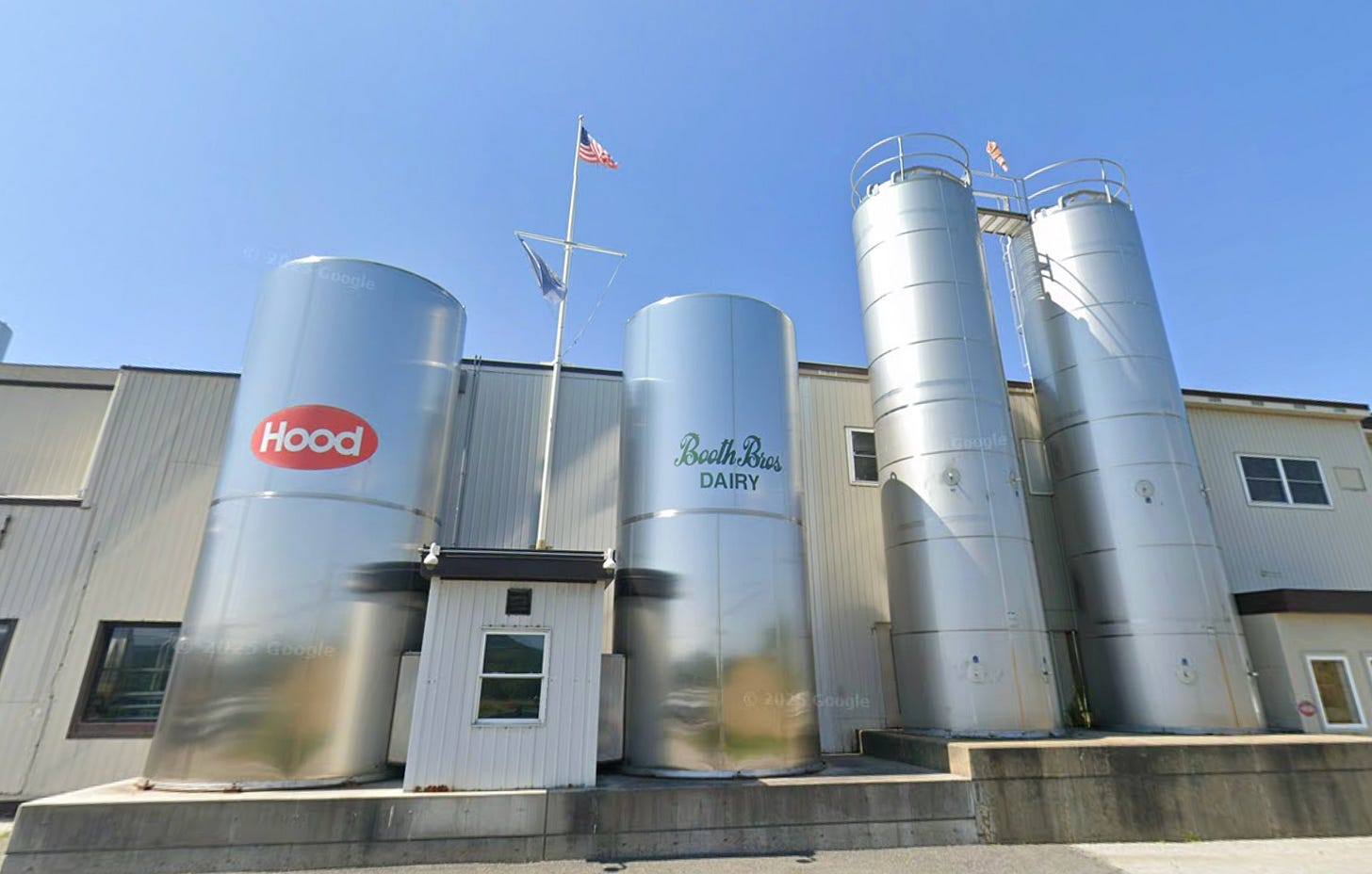With 13 Plants Nationwide, Why Did H.P. Hood Pick the Barre Facility to Close?
H.P. Hood is consolidating its manufacturing footprint into fewer, bigger, and more technologically advanced facilities that can produce higher-margin products at a massive scale.
BARRE, Vt. – After nearly 80 years of bottling milk in the Granite City, the H.P. Hood plant, a facility that began as the family-owned Booth Bros. Dairy, will cease operations by April 2026. The closure will result in the loss of approximately 50 local jobs, marking a significant blow to the community and raising questions about the future of dairy processing in Vermont.
In an email to Compass Vermont confirming the news, Lynne Bohan, Hood’s Group Vice President of Communications & Government Affairs, stated that the company “has made the difficult decision to close its fluid dairy manufacturing facility in Barre, VT.”
The confirmation comes after Hood conducted what Bohan described as a “careful and thorough review of all its fluid milk operations in the Northeast.” The official reasons cited for the closure include the plant’s geographic location, its current production capacity, and rising infrastructure costs.
While H.P. Hood will continue to sell Booth Bros. branded milk in Vermont, the decision to shutter the brand’s historic home leaves many Vermonters asking: In a network of 13 plants across the country, why was this one chosen? The answer appears to lie in a combination of corporate strategy, industry-wide trends, and the economics of modern manufacturing.
A Tale of Two Strategies: Consolidation and Modernization
While the Barre plant faces closure, H.P. Hood has been making massive investments in other facilities, signaling a clear strategic shift towards creating larger, highly efficient “super-plants.” This Tale of Two Strategies shows where the company sees its future, and why smaller, older plants may no longer fit into that vision.
Consider these recent investments:
Batavia, New York: Hood has poured $120 million into its Batavia facility to dramatically increase its capacity for extended-shelf-life (ESL) beverages. This plant features advanced automation, including a sophisticated Automated Storage and Retrieval System (ASRS), making it a high-volume, low-cost production hub.
Frederick County, Virginia: Another $83.5 million is being invested to expand and modernize this plant, adding new production lines and warehouse space for non-dairy and ESL products.
These investments are not just about routine upgrades; they are about fundamentally re-engineering the company’s production network. According to industry analysts, this focus on automation and scale is crucial for competing in a market with tight margins. Furthermore, Hood’s plant in Agawam, Massachusetts, was the first fluid dairy facility in the nation to earn an ENERGY STAR certification, highlighting the company’s intense focus on operational efficiency.
Why Barre Didn’t Make the Cut
Viewed against the backdrop of these massive upgrades elsewhere, the reasons provided by Hood for the Barre closure come into sharper focus.
Production Capacity and Infrastructure Costs: The Barre plant is a standard High Temperature Short Time (HTST) pasteurization facility. While effective, it likely lacks the scale and advanced technology of plants like the one in Batavia. “Rising infrastructure costs” suggests that upgrading the older Barre facility to meet modern efficiency standards would be more expensive and less impactful than investing in a newer, larger plant. It’s often cheaper to expand a modern facility than to gut and rebuild an old one.
Strategic Focus: Hood’s major investments are heavily concentrated in high-growth product categories like ESL milk, oat milk, and other non-dairy alternatives. If the Barre plant’s primary role was bottling traditional fluid milk for a regional market—a category that has seen declining consumption for decades—it would fall outside the company’s main strategic focus for future growth.
Geographic Location: While central to Vermont, the Barre location may be less strategic for distributing products across the wider Northeast and national markets compared to facilities located on major transportation corridors in New York or Virginia.
Essentially, the Barre plant appears to be a casualty of a strategic pivot. H.P. Hood is consolidating its manufacturing footprint into fewer, bigger, and more technologically advanced facilities that can produce higher-margin products at a massive scale.
What This Means for Vermont: The Path Forward
The closure of the Hood plant is more than just a local story; it reflects a broader challenge for Vermont’s entire manufacturing and agricultural sector. The economics of food processing today favor immense scale, which can put smaller states and legacy plants at a disadvantage.
For Vermonters, this moment forces a difficult but necessary conversation. The key questions are not just about saving one plant, but about building a resilient future:
How can Vermont support its existing food processors? Are there state-level programs or incentives that can help smaller, legacy facilities modernize to remain competitive?
What is the future for smaller-scale processing? If competing on volume with massive corporations isn’t viable, can Vermont leverage its powerful brand to focus on value-added, artisanal, or specialty products that command a higher price?
Can the Barre facility be repurposed? The loss of 50 jobs is immediate. Community leaders and state economic development officials will need to explore whether a new manufacturer or food processor could utilize the existing infrastructure and skilled workforce.
The story of Booth Bros. Dairy, founded by Norman and Marcel Booth in 1946 and sold to Hood in 1997, is one of local enterprise being absorbed into a national corporate structure. For Barre, the closure marks the end of an era—a difficult local outcome driven by a global shift in manufacturing strategy that prioritizes efficiency and scale above all else.



